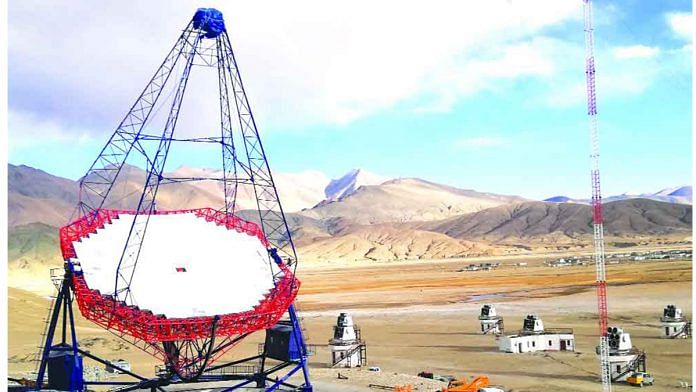New Delhi: India’s largest and the world’s highest gamma-ray telescope is set to go live later this year, aiming to provide a new window into distant stars and galaxies in the universe.
The Major Atmospheric Cherenkov Experiment Telescope (MACE) in Hanle, Ladakh, is placed at an altitude of 4,300 metres above sea level.
It is the world’s second-largest, ground-based gamma-ray telescope with a 21-metre-diameter dish. The largest telescope of the same class is the 28-metre-diameter telescope, which is part of the High Energy Stereoscopic System (HESS) in Namibia.
“The installation of the telescope is complete and trial runs are being carried out. It will go live later this year. The first science results from this project will come in a year or two,” Nilay Bhatt, a researcher at the Bhabha Atomic Research Centre (BARC), told ThePrint.
The project is a collaboration of scientists from BARC, Tata Institute of Fundamental Research (TIFR) and the Indian Institute of Astrophysics, along with the Electronics Corporation of India Limited.
Also read: NASA telescope finds exoplanet trio that can unravel mysteries of planet formation
Will study Cherenkov radiation
MACE is named after Russian scientist Pavel Cherenkov, who discovered that charged particles glow when they pass through a non-conducting medium under certain conditions. This phenomenon known as the Cherenkov radiation causes the characteristic blue glow in underwater nuclear reactors. Cherenkov shared the Nobel Prize in Physics in 1958 with Ilya Frank and Igor Tamm for this discovery.
“The telescope will study different astrophysical sources in energies of 20 GeV to 10 TeV range,” said Bhatt. This range will allow scientists to study high-energy processes in the universe. It may also aid the search for dark matter — the mysterious substance that is believed to account for over 80 per cent of the universe’s mass.
Gamma rays have so much energy that they pass through mirrors used in ordinary optical telescopes. These rays require specialised detectors.
Moreover, the Earth’s atmosphere blocks most of the incoming gamma rays from space, at a height of 10 kilometres from the surface, which makes it difficult for ground-based telescopes to detect them.
Placing the telescope at higher altitudes gives them a significant advantage to observe the Cherenkov radiation, which is produced when cosmic gamma rays strike the Earth’s upper atmosphere.
MACE is equipped with 356 mirror panels and over 1,000 cameras and will detect very short flashes — lasting just a few nanoseconds — of the Cherenkov radiation. All the components of the telescope have been developed in India.
“Our work is complementary to other telescopes. Together, telescopes look at the same objects in different energy windows and then scientists put it all together to get the whole picture of the universe. So this telescope is going to add to the sources that are available to us and make our understanding more comprehensive,” said Bhatt.
Also read: Pune telescope hailed for discovering one of farthest known galaxies




There is already n optical telescope at Hanle. Suggest similar to video clips on politics, The Print science reporters should do mini-videos on science. These could be interviews with scientists at various institutions.